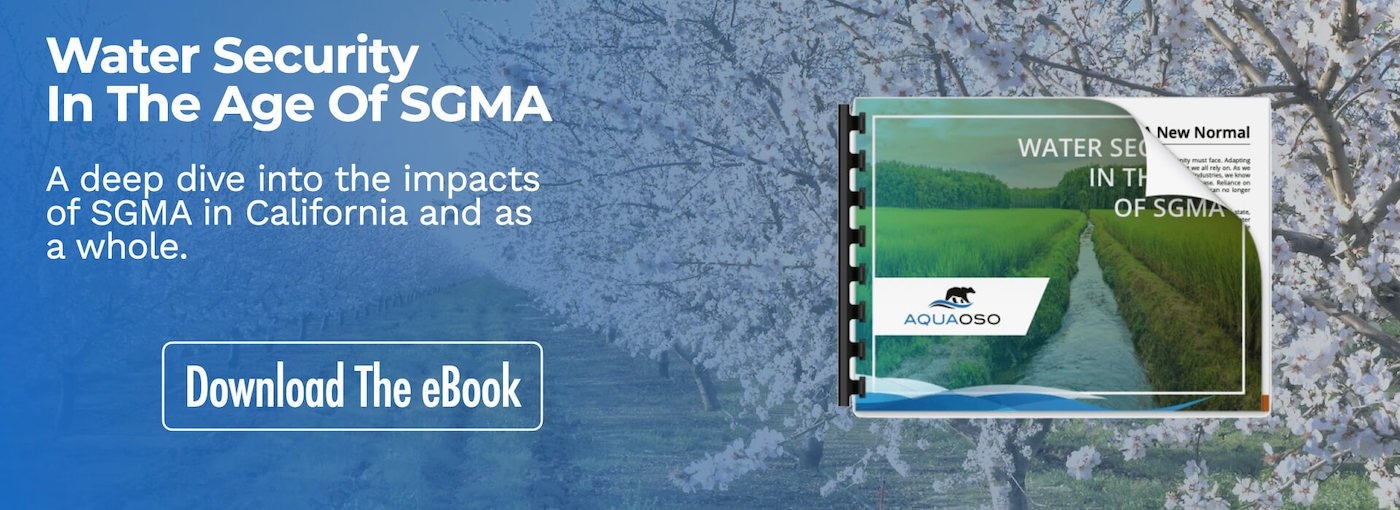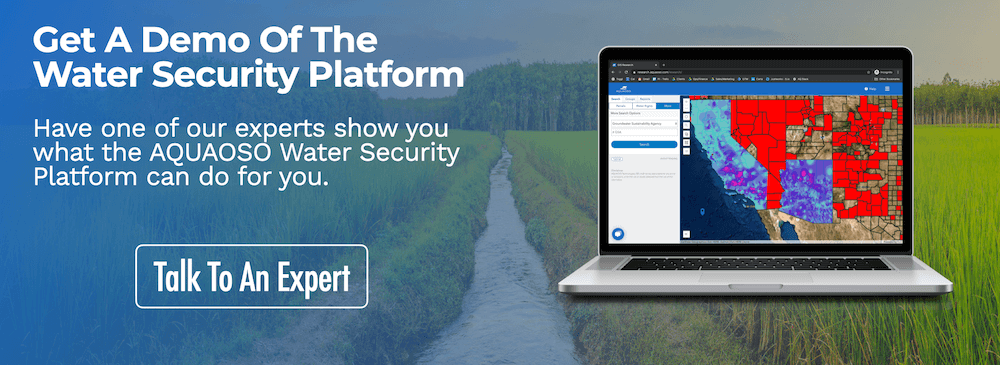Why Water GIS Matters to Ag Professionals and Lenders
Geographic Information System (GIS) technology is used to understand multiple complex layers of data, compiled in a map-based format, usually based on satellite or drone data and other geospatial information. This technology is beginning to trend in the agricultural industry, especially with the rise of ESG reporting.
One of the reasons that water GIS data is so important is that water is local. While it’s important for ag professionals and financial institutions such as ag lenders to keep an eye on macro water trends, it is also important to understand that these trends interact with and affect different regions, people, businesses, and even individual parcels of land, in different ways. There isn’t a single solution to water security issues because different farm operations, water districts, and regions don’t have exactly the same water problems or needs.
Understanding water on a granular, or “small data,” level is key. The more granular the data, the better a problem can be identified, understood, monitored, and mitigated. This article discusses how water GIS can help with this process.
The Benefits of Water GIS Data
GIS data can help ag lenders, investors, and growers visualize and monitor factors such as irrigation, soil quality, crop patterns, and more, in the form of an explorable digital map. By monitoring both inputs and outputs, lenders and investors can monitor the land-use practices of the farming operations in their portfolio and assess and mitigate any water risks. Growers can manage their water resources more efficiently and pinpoint the exact parcels and areas that need correction.
On a larger scale, GIS data is useful for serving as a single source of truth that lenders, investors, and growers can depend on to achieve a mutual understanding of water stress and other factors that affect the viability of farming operations. Access to real-time GIS data allows for better business decisions and reduces human error in data collection.
With ESG reporting on the rise, measurement and valuation will be a top-of-mind interest for financial institutions that will need to report on the sustainability of their portfolios. The ability to fully understand the water situations of the many farm operations and parcels in their portfolios will improve financial institutions’ abilities to comply with the upcoming ESG requirements. GIS is the first step toward this truthful understanding.
Combined with data collected from a growers’ own field sensors, integrated GIS data can provide a more complete picture of water stress in a given parcel than any singular data source alone.
GIS data is also important in the conservation sector because it can help organizations like The Nature Conservatory decide where to invest their resources: “We need maps to tell us the places where specific actions will deliver the greatest return on investment,” they explain in a 2020 report. “These may be individual actions or bundles of actions such as pest control, fire management … easements, or acquisitions.”
Using Water GIS Data
More and more ag lenders and investors want to (and will need to) comply with sustainability regulations when it comes to land and water use, but gaining access to appropriate data is still an obstacle. In a 2020 report by BlackRock called “Sustainability Goes Mainstream,” they write that:
“53% of global respondents cited the poor quality or availability of Environmental, Social, and Governance (ESG) data and analytics as the biggest barrier to deeper or broader implementation of sustainable investing, higher than any other barrier that we tested. This was consistent across all regions.”
One of the reasons that GIS data is so useful is that it provides a level of granularity that other data sources don’t. The USC Dornsife Spatial Sciences Institute explains that 3D GIS software “lets users engage with data from a whole new perspective that results in more nuanced insights and detailed visualizations.”
Instead of being limited by the x and y axes of a 2D map, GIS software allows users to add additional layers, such as surface water, groundwater, soil health, water rights, GSPs and GSAs (SGMA California), well reports, elevation, mineral concentration, the suitability of land for farming or development, and much more. “Working with three dimensions, GIS professionals can often apply their findings to address real-world issues with greater accuracy.”
GIS technology makes it easier to gather data from multiple types of software and data sources, and view the aggregated information all in one place. When it comes to water, GIS can be used to identify regions of water stress, predict impacts of impending water crises, and reduce water use through more efficient irrigation methods.
This is specifically useful to ag finance institutions because of the water risk identification capabilities of GIS.
Real-Time Insights
According to the Environmental Defense Fund, “Agriculture is among the most at-risk sectors to climate change as it depends on natural resources, such as soil and water, and predictable weather, such as temperature and precipitation.”
Having access to real-time insights into climate, drought, wildfires, water scarcity, and other environmental issues will be key to ensuring stable supply chains and a reliable food supply. Ag lenders will have a considerable advantage with access to this information to make responsible business decisions.
GIS data allows users to understand vital data in the context of their properties, such as the viability of a particular crop or the water risk of a particular investment. The real-time nature of good GIS data means that users can have the information they need to make better decisions quickly – and continue to refine their decisions over time.
Ultimately, GIS data will be most useful when paired with human insights, including the on-the-ground experiences of farmers themselves. That’s why a key component of GIS technology is collaboration and transparent data-sharing. One subset of GIS is public participation GIS (PPGIS), which uses surveys, focus groups, and other methods to incorporate first-hand experience into GIS datasets.
One study on agroecology found that “using participatory geospatial methods to explore the synergies between knowledge flows and agroecology broadens our understanding of how environmental sustainability can be achieved.”
As GIS technology evolves, it can be expected see even more applications for water GIS in the agricultural industry.
Learn more in the explorable GIS in Agriculture Guide.
The Bottom Line
GIS combines environmental data with geospatial mapping technology to provide visual insights into soil quality, crop health, water security, and other agricultural issues. Water GIS data can allow financial institutions to assess the water risk in their portfolios accurately and rapidly in order to comply with regulations such as SGMA and the impending ESG requirements.
GIS also allows growers to use water more efficiently and mitigate the risks associated with water stress and climate change.
The granularity of GIS data also makes it suitable for lenders and investors looking for insight into the water security of individual parcels of land or growing operations. With better data, ag professionals can make better decisions and mitigate water risk.
Browse our resources page to learn more about water security or contact us directly to discuss how water GIS data can help you!
Recent Posts
Agcor and AgWare Celebrate 2 Years of Groundbreaking Integration, Setting the Standard in Agricultural Appraisal Efficiency
PRESS RELEASE For Immediate Release DENVER, March 21, 2024 -- Agcor, an AQUAOSO Technologies, PBC brand, a leading provider of agricultural lending software solutions, announces a significant milestone in its partnership with AgWare, a premier developer of innovative...
AQUAOSO launches Agcor – a full suite of digital tools for the modern ag lender.
PRESS RELEASE For Immediate Release Denver, CO - Today, AQUAOSO Technologies, PBC officially unveiled Agcor™ - a suite of software tools for the modern ag lender. The software is purpose-built by and for agricultural lenders to unlock the power of...
AQUAOSO’s Climate Intelligence Platform Showcased At OnRamp Conference
PRESS RELEASE For Immediate Release AQUAOSO showcases GIS Connect, a climate intelligence platform that helps US financial institutions mitigate climate risk during the recent OnRamp Agriculture conference. AQUAOSO shares their story of substantial growth as...



